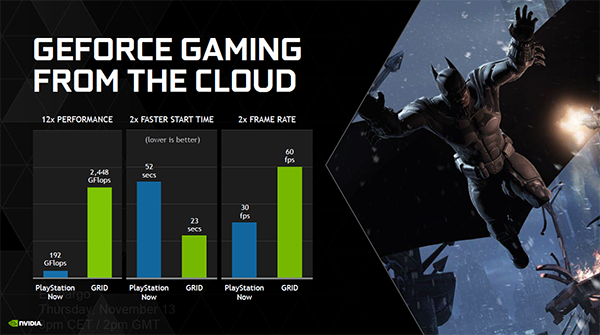'The Netflix of Gaming'
Nvidia is today unveiling another strand in its gaming philosophy with the announcement of the GRID Gaming service for the Shield tablet. This, it hopes, will pave the way for the company to become the 'Netflix of gaming.' Lofty ambitions indeed.
Using similar technology employed in local Gamestream streaming, where a GeForce-powered PC's graphics grunt is sent over wirelessly to a Shield tablet usually connected to a modern TV via HDMI, enabling high-quality gaming on a big screen, Nvidia is now ready to roll it out from the cloud.
Nvidia's take on cloud gaming uses GRID servers housing the company's K520 GPUs. These are connected to the Amazon Cloud Services backbone and to your home router via the ISP. The heavy-lifting game processing takes place on these GRID Gaming servers, is compressed, and then sent to a client device such as the Shield tablet.
Console-like Quality From the Cloud
The premise is to enable high-quality cloud-based gaming on the Shield tablet that is indistinguishable from streaming it locally, thus offering a premium PC-esque gaming experience on a handheld tablet.
Streaming is, in fact, a misnomer of sorts, because gaming requires controller actions to be sent back to the server with the appropriate gaming response returned within a fraction of a second.
Cloud gaming isn't new, of course, and recent history teaches us that it is fraught with problems. OnLive and Gaikai (now owned by Sony) have dallied with cloud-stream gaming with limited success. Nvidia hopes to go one better the GRID Gaming.
Effective cloud gaming is built on the foundations of a decent Internet connection for, crucially, both bandwidth and latency. Nvidia recommends a 10Mbit/s download speed for optimal gaming. Behind-the-scenes technology minimises lag (latency) - the Achilles heel of cloud-based services, particularly for fast-paced games - and, in theory, produces gaming thrills and spills and response times on a par with the latest consoles.
During a press event held in Reading earlier this week, Nvidia went on to say that, at optimal levels, via the recipient Shield device, GRID is able to produce image quality on a par with running a discrete GeForce GTX 760 GPU.
The Nuts and Bolts
Demonstrating this cloud-based approach, Nvidia had a Shield tablet hooked-up to a Netgear 802.11ac router in turn connected to a GRID server in Dublin.
Updated to a preview build of Android L(ollipop), the demo Shield tablet's hub includes a new section for GRID Gaming that's used to access the games stored on the server. Nvidia says there will be approximately 20 at launch, detailed above, with more arriving in coming months.
Though none are considered triple-A titles now, each game is the full version and is free to play. It is likely that Nvidia will charge a Netflix-like monthly fee once enough developers and compelling titles are onboard, but up until June 30, 2015, they remain free for Shield Tablet and first-generation Shield owners.

The GRID configuration screen tests for bandwidth, latency, jitter and frame loss, setting the appropriate image quality for streaming. Games then take about 25 seconds to load. The overall effect is identical to using local Gamestream, with, for the most part, no obvious lag between controller input and onscreen action.
Testing GRID's mettle, we played through a couple of rounds of Streetfighter; action was smooth, predictable and consistent at all times, and it was easy to forget the game was being streamed from 400 miles away.
The initial GRID rollout will occur in North America first, followed by Europe and Asia. Distance to server is key in ensuring a minimal lag cloud-based gaming experience; Nvidia claims it will be able to deliver a sub-60ms latency for most gamers.
Potential and Pitfalls
Shield with GRID opens up a number of new possibilities and pitfalls for Nvidia. Using the tablet as a conduit for streaming high-quality gaming has an instant, attractive lure for potentially millions of users. Nvidia will likely begin charging a nominal monthly fee once there's enough compelling content on the servers, but getting to that stage requires delicate cooperation with the big gaming studios who aren't going to license their newest games in a hurry.
Then there's a question of how such an approach can impact the company's discrete GPU business. Will you still consider purchasing an add-in GeForce card if GRID Gaming is able to deliver on its promise of high-quality server-side rendering? Will GRID Gaming come to other devices? And how does Nvidia plan on using mobile 4G in the overall GRID Gaming proposition? There are certainly more questions than answers at this moment.
Said to be over 10 years in development, GRID has to work flawlessly from inception for it to be accepted as another viable way of gaming. Nvidia can control the quality of the servers and content to a large degree, but it can't legislate for how good your Internet connection is. Unlike movies, streaming games is inherently more complex, so we expect GRID to remain in beta for a while, with Nvidia ironing out the kinks as it goes along.
Nvidia understands that streaming can, if implemented correctly, change the way in which many consumers play games on their tablet and living room. Exclusive and free for the Shield, GRID is pregnant with promise. We'll report back with more hands-on experience as GRID Gaming is rolled out.

















